Characteristics of Dust Weather in the Tarim Basin from 1989 to 2021 and Its Impact on the Atmospheric Environment
Abstract
:1. Introduction
2. Study Area
3. Data and Methods
3.1. Dust Weather Observation Data
3.2. Assimilation Data
3.3. Dust Intensity Index
4. Results and Analysis
4.1. Temporal and Spatial Distribution Characteristics of Dust Weather
4.1.1. Time Variation in Dust Weather Frequency
4.1.2. Spatial Distribution of Dust Weather Days
4.2. Temporal and Spatial Distribution Change of DI
4.2.1. DI Annual Change and Monthly Change
4.2.2. DI Spatial Variation
4.3. DAOD Distribution Characteristics
5. Discussion
5.1. Surface Dust Distribution
5.2. Influence of Wind on Dust Distribution
6. Conclusions
- (1)
- From 1989 to 2021, on average, there were 60 dust days/year in the Tarim Basin. The dust weather is mainly composed of floating dust, followed by blowing dust and dust storms. The interannual variation in different types of dust weather frequency shows a downward trend. In terms of spatial distribution, the dust weather in the Tarim Basin is mainly distributed in the southern edge of the basin and Tazhong Station in the hinterland of the desert, showing a spatial pattern of more in the south and less in the north.
- (2)
- The interannual variation in DI shows no significant downward trend, and the spatial distribution of DI is basically consistent with that of dust weather days. The high-value area is mainly located in the line from Pishan to Ruoqiang and Tazhong in the south, while the DI value in the north is relatively low. The DI values have an obvious seasonal difference, i.e., spring (77.82) > summer (56.97) > autumn (18.34) > winter (7.33), and the DI values of most stations in autumn and winter are less than 20.
- (3)
- The DAOD in the Tarim Basin is obviously affected by dust weather and has a significant correlation with the dust weather days and the DI. The strong wind–sand activity in spring makes the DAOD of the entire basin generally high, especially in the Hotan area in the south of the basin, and Aksu and the surrounding areas in the north. In addition, the dry lake basin of the Eastern Taitma Lake provides a rich material base, making the DAOD of its surrounding areas high. The DAOD data have strong time continuity and a wide distribution range, compensating for the shortage of ground dust observation data.
- (4)
- The DUSMASS is affected by many factors, such as terrain and atmospheric circulation, and its high value decreases from the east of the Taklimakan Desert to the hinterland of the desert. Wind is one of the important factors affecting the release of dust. The distribution of the gale weather frequency is similar to that of the DUSMASS, showing a stepwise decreasing trend from northeast to southwest. A high average wind speed was recorded in the northeast of the desert, followed by the southern edge of the basin.
Author Contributions
Funding
Conflicts of Interest
Appendix A
| Station | Longitude | Latitude | Station | Longitude | Latitude |
|---|---|---|---|---|---|
| Wushi | 79.23 | 41.22 | Tazhong | 83.67 | 39.00 |
| Akesu | 80.23 | 41.17 | Tieganlike | 87.7 | 40.63 |
| Wensu | 80.23 | 41.27 | Ruoqiang | 88.17 | 39.03 |
| Baichen | 81.90 | 41.78 | Qiemo | 85.55 | 38.15 |
| Xinhe | 82.62 | 41.53 | Pishan | 78.28 | 37.62 |
| Shaya | 82.78 | 41.23 | Cele | 80.80 | 37.02 |
| Kuche | 82.97 | 41.72 | Moyu | 79.72 | 37.28 |
| Keping | 79.05 | 40.50 | Hetian | 79.93 | 37.13 |
| Awati | 80.40 | 40.65 | Luopu | 80.17 | 37.08 |
| Alaer | 81.27 | 40.55 | Minfeng | 82.72 | 37.07 |
| Baluntai | 86.30 | 42.73 | Yutian | 81.65 | 36.85 |
| Bayinbuluk | 84.15 | 43.03 | Tuergate | 75.40 | 40.52 |
| Hejing | 86.40 | 42.32 | Jiashi | 76.73 | 39.50 |
| Yanqi | 86.57 | 42.08 | Hashi | 75.98 | 39.47 |
| Heshuo | 86.80 | 42.25 | Bachu | 78.57 | 39.80 |
| Luntai | 84.25 | 41.78 | Yuepuhu | 76.78 | 39.25 |
| Yuli | 86.27 | 41.35 | Yingjisha | 76.17 | 38.93 |
| Kuerle | 86.13 | 41.25 | Tashikuergan | 75.23 | 37.77 |
| Atushi | 76.17 | 39.72 | Maigaiti | 77.63 | 38.92 |
| Wuqia | 75.25 | 39.72 | Shache | 77.27 | 38.43 |
| Aketao | 75.95 | 39.15 | Yecheng | 77.40 | 37.92 |
| Aheqi | 78.45 | 40.93 | Zepu | 77.27 | 38.20 |
References
- Liu, Z. The Occurrence and Development of Sand and Dust Weather in the Typical Area of Southern Xinjiang, China. Master’s Thesis, Shihezi University, Xinjiang, China, 2016. [Google Scholar]
- China Meteorological Administration. Specifications for Ground Meteorological Observation; Meteorological Publishing House: Beijing, China, 1979; pp. 21–27.
- Tegen, L.; Lacis, A.A.; Fung, L. The influence on climate forcing of mineral aerosols from disturbed soil. Nature 1996, 380, 419–422. [Google Scholar] [CrossRef]
- Zhu, B.-Q.; Zhang, J.-X.; Sun, C. Potential links of gobi, dust, and desertification: A comprehensive understanding from aeolian landform evolution in a middle-latitude desert. Sediment. Geol. 2021, 428, 106049. [Google Scholar] [CrossRef]
- Kang, J.-H.; Liu, T.-C.; Keller, J.; Lin, H.-C. Asian dust storm events are associated with an acute increase in stroke hospitalisation. J. Epidemiol. Community Health 2013, 67, 125–131. [Google Scholar] [CrossRef]
- Karagulian, F.; Temimi, M.; Ghebreyesus, D.; Weston, M.; Kondapalli, N.K.; Valappil, V.K.; Aldababesh, A.; Lyapustin, A.; Chaouch, N.; Al Hammadi, F.; et al. Analysis of a severe dust storm and its impact on air quality conditions using WRF-Chem modeling, satellite imagery, and ground observations. Air Qual. Atmosphere Health 2019, 12, 453–470. [Google Scholar] [CrossRef]
- Sokolik, I.N.; Toon, O.B. Direct radiative forcing by anthropogenic airborne mineral aerosols. Nature 1996, 381, 681–683. [Google Scholar] [CrossRef]
- Huang, J.; Minnis, P.; Yan, H.; Yi, Y.; Chen, B.; Zhang, L.; Ayers, J.K. Dust aerosol effect on semi-arid climate over Northwest China detected from A-Train satellite measurements. Atmos. Chem. Phys. 2010, 10, 6863–6872. [Google Scholar] [CrossRef]
- Chen, X.; Ding, J.; Liu, J.; Wang, J.; Ge, X.; Wang, R.; Zuo, H. Validation and comparison of high-resolution MAIAC aerosol products over Central Asia. Atmos. Environ. 2021, 251, 118273. [Google Scholar] [CrossRef]
- Sun, J.; Zhang, M.; Liu, T. Spatial and temporal characteristics of dust storms in China and its surrounding regions, 1960–1999: Relations to source area and climate. J. Geophys. Res. Atmos. 2001, 106, 10325–10333. [Google Scholar] [CrossRef]
- Uno, I.; Amano, H.; Emori, S.; Kinoshita, K.; Matsui, I.; Sugimoto, N. Trans-Pacific yellow sand transport observed in April 1998: A numerical simulation. J. Geophys. Res. Atmos. 2001, 106, 18331–18344. [Google Scholar] [CrossRef]
- Chun, Y.; Boo, K.-O.; Kim, J.; Park, S.-U.; Lee, M. Synopsis, transport, and physical characteristics of Asian dust in Korea. J. Geophys. Res. Atmos. 2001, 106, 18461–18469. [Google Scholar] [CrossRef]
- Luo, X.; Zhang, Y. The Linkage between Upper-Level Jet Streams over East Asia and East Asian Winter Monsoon Variability. J. Clim. 2015, 28, 9013–9028. [Google Scholar] [CrossRef]
- Zheng, X.; Kang, D.; Yang, X.; Yang, F.; He, Q. Statistical Analysis of Dust Weather Frequency in Taklamakan Desert. Environ. Sci. Manag. 2021, 46, 133–137. [Google Scholar]
- Tan, Z.; Liu, Y.; Zhu, Q.; Bi, J. Effect of dust aerosols on the heat exchange over the Taklimakan Desert. Atmos. Environ. 2022, 276, 119058. [Google Scholar] [CrossRef]
- Gao, H.; Washington, R. The spatial and temporal characteristics of TOMS AI over the Tarim Basin, China. Atmos. Environ. 2009, 43, 1106–1115. [Google Scholar] [CrossRef]
- De Meij, A.; Bossioli, E.; Penard, C.; Vinuesa, J.; Price, I. The effect of SRTM and Corine Land Cover data on calculated gas and PM10 concentrations in WRF-Chem. Atmos. Environ. 2015, 101, 177–193. [Google Scholar] [CrossRef]
- Sujitha, P.; Santra, P.; Bera, A.; Verma, M.; Rao, S. Detecting dust loads in the atmosphere over Thar desert by using MODIS and INSAT-3D data. Aeolian Res. 2022, 57, 100814. [Google Scholar] [CrossRef]
- Wang, S.; Wang, J.; Zhou, Z.; Shang, K. Regional characteristics of three kinds of dust storm events in China. Atmos. Environ. 2005, 39, 509–520. [Google Scholar] [CrossRef]
- Kong, X.; Wang, Y.; Huang, K.; Jia, Y.; Wang, P. Spatio-Temporal Characteristics of Dust Weather in Spring 2021 in China. For. Resour. Manag. 2022, 3, 117–121. [Google Scholar] [CrossRef]
- Gui, K.; Yao, W.; Che, H.; An, L.; Zheng, Y.; Li, L.; Zhao, H.; Zhang, L.; Zhong, J.; Wang, Y.; et al. Record-breaking dust loading during two mega dust storm events over northern China in March 2021: Aerosol optical and radiative properties and meteorological drivers. Atmos. Chem. Phys. 2022, 22, 7905–7932. [Google Scholar] [CrossRef]
- Filonchyk, M. Characteristics of the severe March 2021 Gobi Desert dust storm and its impact on air pollution in China. Chemosphere 2022, 287, 132219. [Google Scholar] [CrossRef]
- He, Y.; Yi, F.; Yin, Z.; Liu, F.; Yi, Y.; Zhou, J. Mega Asian dust event over China on 27–31 March 2021 observed with space-borne instruments and ground-based polarization lidar. Atmos. Environ. 2022, 285, 119238. [Google Scholar] [CrossRef]
- Ding, R.; Wang, S.; Shang, K.; Yang, D. Analyses of sand storm and sand blowing weather trend and jump in China in recent 45 years. J. Desert Res. 2003, 23, 306–310. [Google Scholar]
- Chen, J.; Guo, X.; Bai, W.; Wen, X.; Yang, Y. Spatiotemporal characteristics and influencing factors of dust weather in Qaidam Basin in recent 60 years. Arid. Zone Res. 2021, 38, 1040–1047. [Google Scholar] [CrossRef]
- Yang, M.; Zhu, X.; Ai, W.; Song, W. Multi-factor prediction of spring dust weather frequency in northern China. Sci. Technol. Guide 2019, 20, 19–29. [Google Scholar] [CrossRef]
- Bergametti, G.; Rajot, J.; Marticorena, B.; Féron, A.; Gaimoz, C.; Chatenet, B.; Coulibaly, M.; Koné, I.; Maman, A.; Zakou, A. Rain, Wind, and Dust Connections in the Sahel. J. Geophys. Res. Atmos. 2022, 127, e2021JD035802. [Google Scholar] [CrossRef]
- Qiu, X.F.; Zeng, Y.; Miao, Q.L. Temporal-spatial distribution as well as tracks and source areas of sand-dust storms in China. Acta Geogr. Sin. 2001, 56, 316–322. [Google Scholar] [CrossRef]
- Shao, Y.; Yang, Y.; Wang, J.; Song, Z.; Leslie, L.M.; Dong, C.; Zhang, Z.; Lin, Z.; Kanai, Y.; Yabuki, S.; et al. Northeast Asian dust storms: Real-time numerical prediction and validation. J. Geophys. Res. Atmos. 2003, 108, 4691. [Google Scholar] [CrossRef]
- Shen, Y.-J.; Guo, Y.; Zhang, Y.; Pei, H.; Brenning, A. Review of historical and projected future climatic and hydrological changes in mountainous semiarid Xinjiang (northwestern China), central Asia. Catena 2019, 187, 104343. [Google Scholar] [CrossRef]
- Yassin, M.F.; Almutairi, S.K.; Al-Hemoud, A. Dust storms backward Trajectories’ and source identification over Kuwait. Atmos. Res. 2018, 212, 158–171. [Google Scholar] [CrossRef]
- Kamargul, A.; Mao, D.; Wang, X.; Cao, Y. Temporal and Spatial Variation Characteristics of Dust Weather in Hotan Area in Recent 60 Years. J. Gansu Agric. Univ. 2022, 57, 145–152+163. [Google Scholar] [CrossRef]
- Rienecker, M.M.; Suarez, M.J.; Gelaro, R.; Todling, R.; Bacmeister, J.; Liu, E.; Bosilovich, M.G.; Schubert, S.D.; Takacs, L.; Kim, G.-K.; et al. MERRA: NASA’s Modern-era retrospective analysis for research and applications. J. Clim. 2011, 24, 3624–3648. [Google Scholar] [CrossRef]
- Gelaro, R.; McCarty, W.; Suárez, M.J.; Todling, R.; Molod, A.; Takacs, L.; Randles, C.A.; Darmenov, A.; Bosilovich, M.G.; Reichle, R.; et al. The Modern-Era Retrospective Analysis for Research and Applications, Version 2 (MERRA-2). J. Clim. 2017, 30, 5419–5454. [Google Scholar] [CrossRef]
- Meng, X.; Guo, J.; Han, Y. Preliminarily assessment of ERA5 reanalysis data. J. Mar. Meteorol. 2018, 38, 91–99. [Google Scholar] [CrossRef]
- Kong, F. Spatial and temporal evolution characteristics of days of disastrous dust weather in China from 1961 to 2017. J. Arid. Land Resour. Environ. 2020, 34, 116–123. [Google Scholar] [CrossRef]
- Chen, S.; Huang, J.; Qian, Y.; Zhao, C.; Kang, L.; Yang, B.; Wang, Y.; Liu, Y.; Yuan, T.; Wang, T.; et al. An overview of mineral dust modeling over East Asia. J. Meteorol. Res. 2017, 31, 633–653. [Google Scholar] [CrossRef]
- Huang, J.; Wang, T.; Wang, W.; Li, Z.; Yan, H. Climate effects of dust aerosols over East Asian arid and semiarid regions. J. Geophys. Res. Atmos. 2014, 119, 11398–11416. [Google Scholar] [CrossRef]
- Liu, J.; Ding, J.; Li, X.; Zhang, J.; Liu, B. Identification of dust aerosols, their sources, and the effect of soil moisture in Central Asia. Sci. Total Environ. 2023, 868, 161575. [Google Scholar] [CrossRef]
- Jia, R.; Liu, Y.; Wu, C.; Zhu, Q.; Wang, B. Three-dimensional Distribution and Transport Process of Dust Aerosols over China from 2007 to 2017. J. Desert Res. 2019, 39, 108–117. [Google Scholar] [CrossRef]
- Li, J.; He, Q.; Jin, L.; Ge, X. Three-dimensional distribution of dust aerosols over the Tarim Basin and the Tibet Plateau during 2007–2021 derived from CALIPSO lidar observations. J. Clean. Prod. 2023, 400, 136746. [Google Scholar] [CrossRef]
- Wang, H. The Monitoring Study for Dust Emission of Wind Erosion Land Surface in the Taklimakan Desert; Cold and Arid Regions Environment and Engineering Research Institute, Chinese Academy of Sciences: Lanzhou, China, 2011. [Google Scholar]
- Charlson, R.J.; Schwartz, S.E.; Hales, J.M.; Cess, R.D.; Coakley, J.A., Jr.; Hansen, J.E.; Hofmann, D.J. Climate Forcing by Anthropogenic Aerosols. Science 1992, 255, 423–430. [Google Scholar] [CrossRef] [PubMed]
- Zhang, Y.; Wang, H.; Zuo, H.; Yan, M. Identify high frequent dust areas and their sources in spring in the Northwest of China. China Environ. Sci. 2019, 39, 4065–4073. [Google Scholar] [CrossRef]
- Ge, J.; Huang, J.; Xu, C.; Qi, Y.; Liu, H. Characteristics of Taklimakan dust emission and distribution: A satellite and reanalysis field perspective. J. Geophys. Res. Atmos. 2014, 119, 11772–11783. [Google Scholar] [CrossRef]
- Prospero, J.M.; Ginoux, P.; Torres, O.; Nicholson, S.E.; Gill, T.E. Environmental characterization of global sources of atmospheric soil dust identified with the nimbus 7 total ozone mapping spectrometer (toms) absorbing aerosol product. Rev. Geophys. 2002, 40, 2-1-2-31. [Google Scholar] [CrossRef]
- Kaufman, Y.J.; Koren, I.; Remer, L.A.; Tanré, D.; Ginoux, P.; Fan, S. Dust transport and deposition observed from the Terra-Moderate Resolution Imaging Spectroradiometer (MODIS) spacecraft over the Atlantic Ocean. J. Geophys. Res. Atmos. 2005, 110, D10S12. [Google Scholar] [CrossRef]
- Chen, Y.; Wang, T.; Han, Y.; Qiao, H.; Sun, M.; Hang, Z. Comparative Analysis of Aerosol Optical Properties in Typical Regions of Mineral Dust and Salt Dust. Plateau Meteorol. 2020, 39, 859–869. [Google Scholar] [CrossRef]
- Li, C.; Zhang, Y.; Liu, Z.; Wang, R. Response of desertification to climate change and Control Countermeasures in Xinjiang. Bull. Soil Water Conserv. 2014, 34, 264–268. [Google Scholar] [CrossRef]
- Han, Z.; Wang, T.; Dong, Z.; Wu, Q.; Yao, Z. Spatial-temporal distribution of blown sand activities along Taklimakan Desert Highway. Sci. Geogr. Sinica. 2005, 25, 455–460. [Google Scholar]
- Bullard, J.E.; Livingstone, I. Dust. In Geomorphology of Desert Environments; Parsons, A.J., Abrahams, A.D., Eds.; Springer: Dordrecht, The Netherlands, 2009; pp. 629–654. [Google Scholar]
- Wei, G.; Zhang, C.; Li, Q.; Wang, R.; Wang, H.; Zhang, Y.; Yuan, Y.; Li, W. Grain-size composition of the surface sediments in Chinese deserts and the associated dust emission. Catena 2022, 219, 106615. [Google Scholar] [CrossRef]
- Sun, Y.; Li, S.; Xu, X.; Li, Y.; Fan, D. Study on Grain Size Characteristics of Dustfall in the Taklimakan Desert—A Case Study along the Tarim Desert Highway. Arid. Zone Res. 2010, 27, 785–792. [Google Scholar] [CrossRef]
- Okin, G.S. Linked aeolian—Vegetation systems. In Treatise on Geomorphology: Aeolian Geomorphology; Shroder, J., Lancaster, N., Sherman, D.J., Baas, A.C.W., Eds.; Academic Press: San Diego, CA, USA, 2013; Volume 11, pp. 428–439. [Google Scholar]
- Jiang, Q.; Yang, X. Sedimentological and Geochemical Composition of Aeolian Sediments in the Taklamakan Desert: Implications for Provenance and Sediment Supply Mechanisms. J. Geophys. Res. Earth Surf. 2019, 124, 1217–1237. [Google Scholar] [CrossRef]
- Washington, R.; Todd, M.; Middleton, N.J.; Goudie, A.S. Dust-Storm Source Areas Determined by the Total Ozone Monitoring Spectrometer and Surface Observations. Ann. Assoc. Am. Geogr. 2003, 93, 297–313. [Google Scholar] [CrossRef]
- Zhang, B.; Tsunekawa, A.; Tsubo, M. Contributions of sandy lands and stony deserts to long-distance dust emission in China and Mongolia during 2000–2006. Glob. Planet. Chang. 2008, 60, 487–504. [Google Scholar] [CrossRef]
- Wu, Z. Aeolian Landform and Sand Control Engineering; Science Press: Beijing, China, 2003; pp. 16–21. [Google Scholar]
- Qiang, M.; Chen, F.; Zhou, A.; Xiao, S.; Zhang, J.; Wang, Z. Impacts of wind velocity on sand and dust deposition during dust storm as inferred from a series of observations in the northeastern Qinghai–Tibetan Plateau, China. Powder Technol. 2007, 175, 82–89. [Google Scholar] [CrossRef]
- Jiao, M.; Niu, R.; Zhao, L.; Yan, H. Comparative analysis on causing factors of dust events. J. Desert Res. 2004, 24, 696–700. [Google Scholar] [CrossRef]
- Chen, Y.; Shang, K.; Wang, S.; Li, Y. Characteristics of sand-dust weather in northern China from 2002 to 2010 and its relationship with surface wind speed and NDVI. J. Desert Res. 2012, 32, 1702–1709. [Google Scholar] [CrossRef]
- Lou, S.; Russell, L.M.; Yang, Y.; Xu, L.; Lamjiri, M.A.; DeFlorio, M.J.; Miller, A.J.; Ghan, S.J.; Liu, Y.; Singh, B. Impacts of the East Asian Monsoon on springtime dust concentrations over China. J. Geophys. Res. Atmos. 2016, 121, 8137–8152. [Google Scholar] [CrossRef]
- Chen, W.; Dong, Z.; Yang, Z.; Han, Z.; Zhang, J.; Zhang, M. Threshold velocities of sand-driving wind in the Taklamakan Desert. Acta Geogr. Sin. 1995, 4, 360–367. [Google Scholar]
- Sun, W.; Gao, X. Geomorphology of sand dunes in the Taklamakan Desert based on ERA5 reanalysis data. J. Arid. Environ. 2022, 207, 104848. [Google Scholar] [CrossRef]
- Zu, R.; Xue, X.; Qiang, M.; Yang, B.; Qu, J.; Zhang, K. Characteristics of near-surface wind regimes in the Taklimakan Desert, China. Geomorphology 2008, 96, 39–47. [Google Scholar] [CrossRef]
- Zu, R. Characteristics of Near-Surface Wind Regimes in the Taklimakan Desert, China; Cold and Arid Regions Environmental and Engineering Research Institute, Chinese Academy of Sciences: Lanzhou, China, 2003. [Google Scholar]
- Kang, L.; Ji, M.; Huang, J.; Guan, X. Impact of eurasian atmospheric circulation on spring dust events in spring over the northern China. J. Desert Res. 2013, 5, 1453–1460. [Google Scholar] [CrossRef]
- Xi, X.; Sokolik, I.N. Dust interannual variability and trend in Central Asia from 2000 to 2014 and their climatic linkages. J. Geophys. Res. Atmos. 2015, 120, 12175–12197. [Google Scholar] [CrossRef]

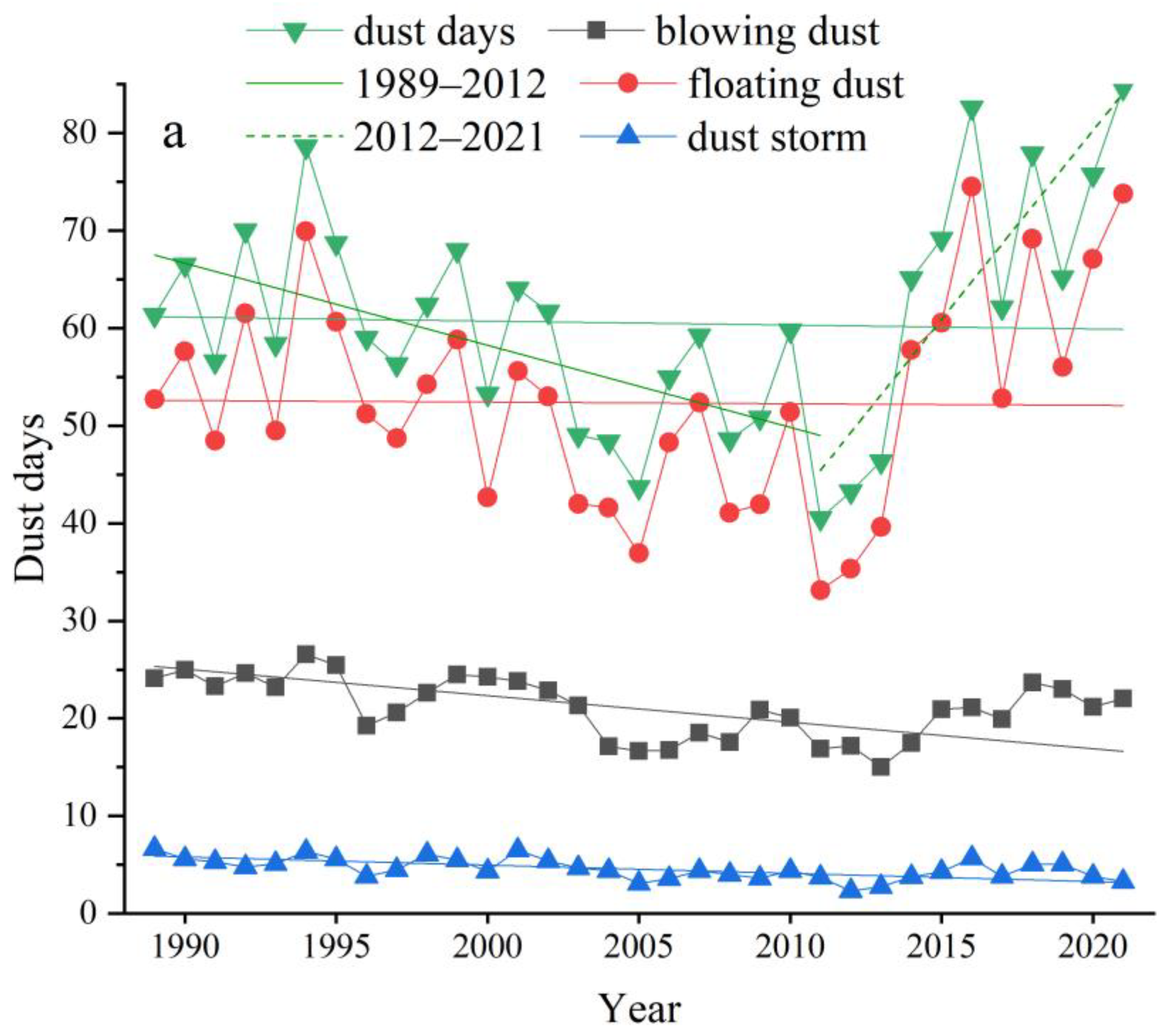

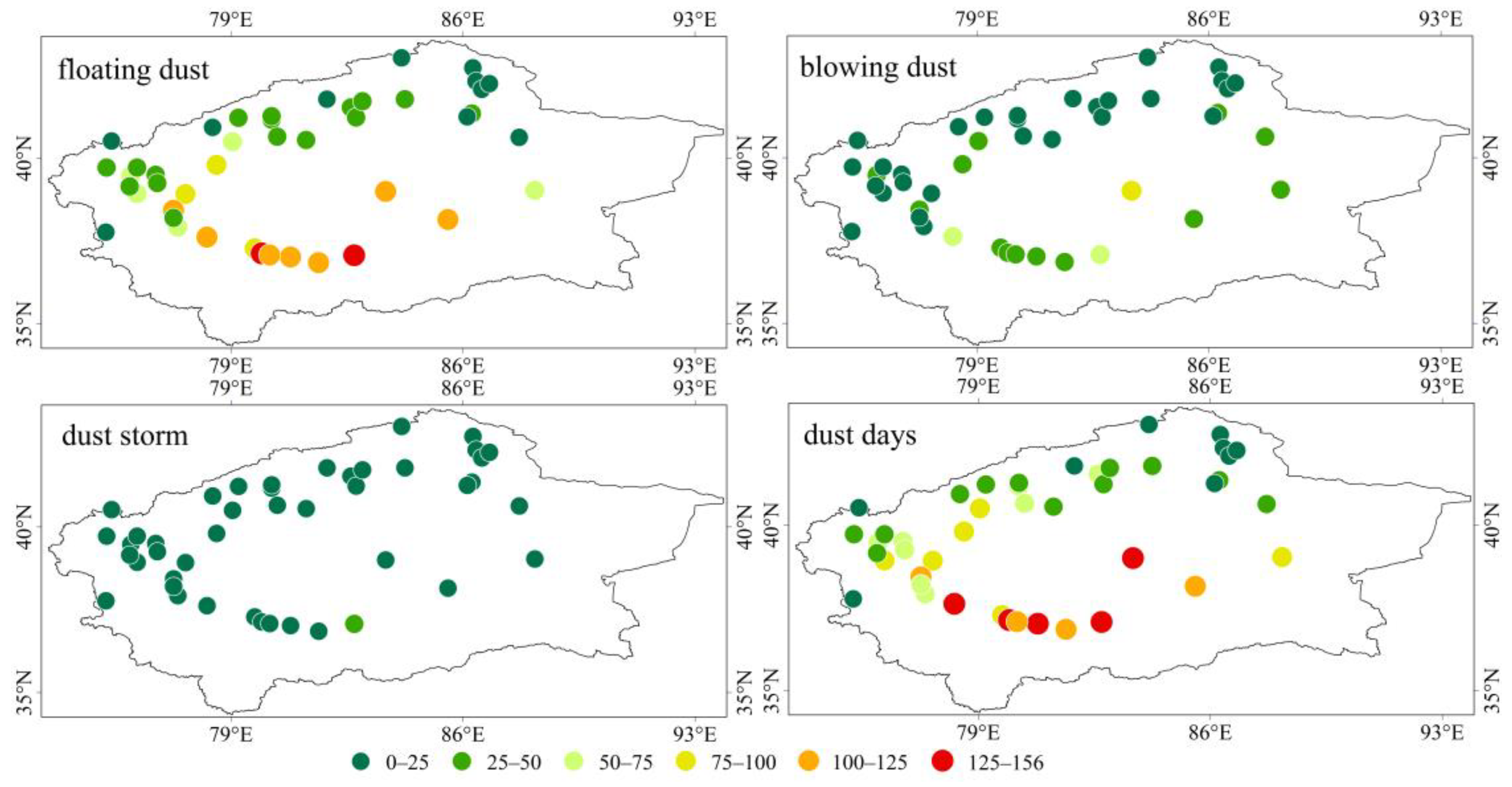

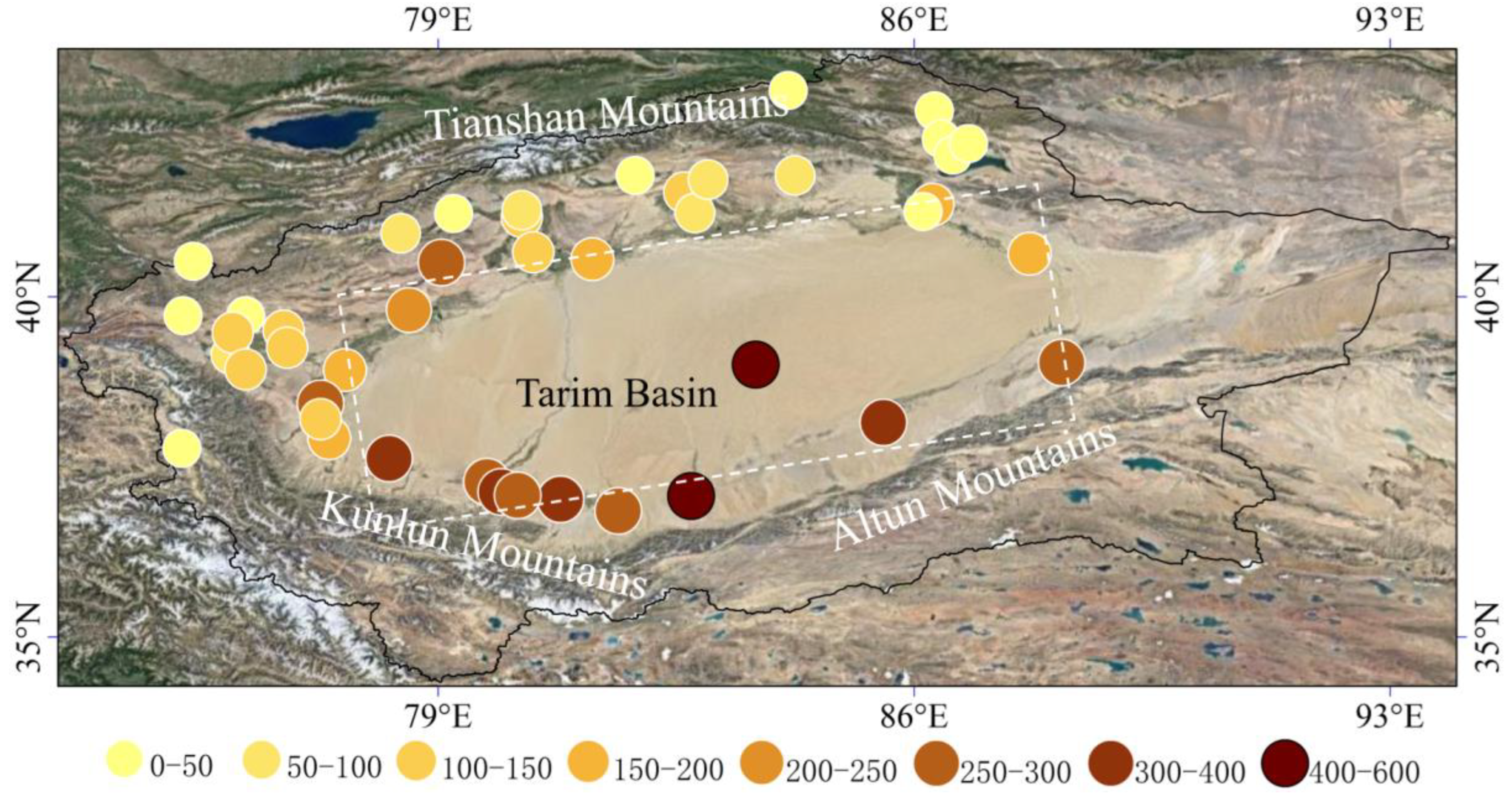
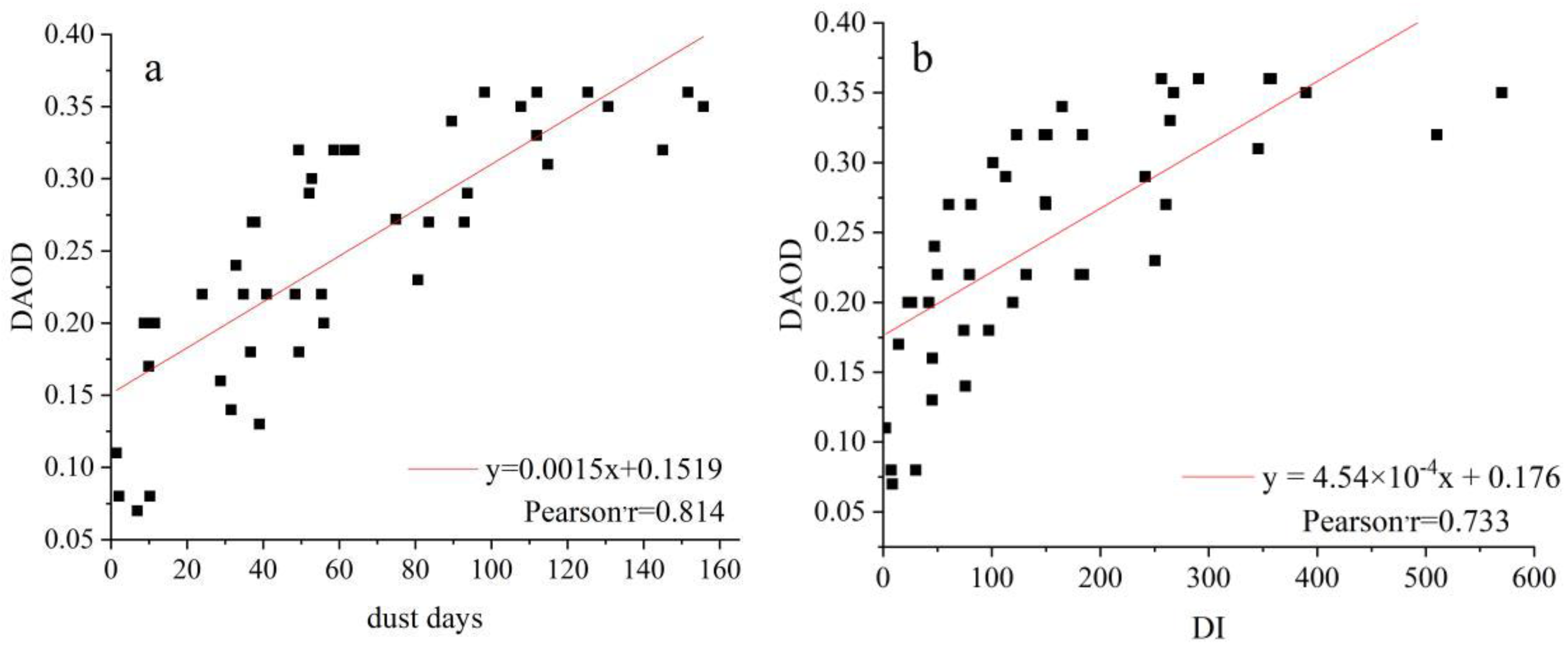
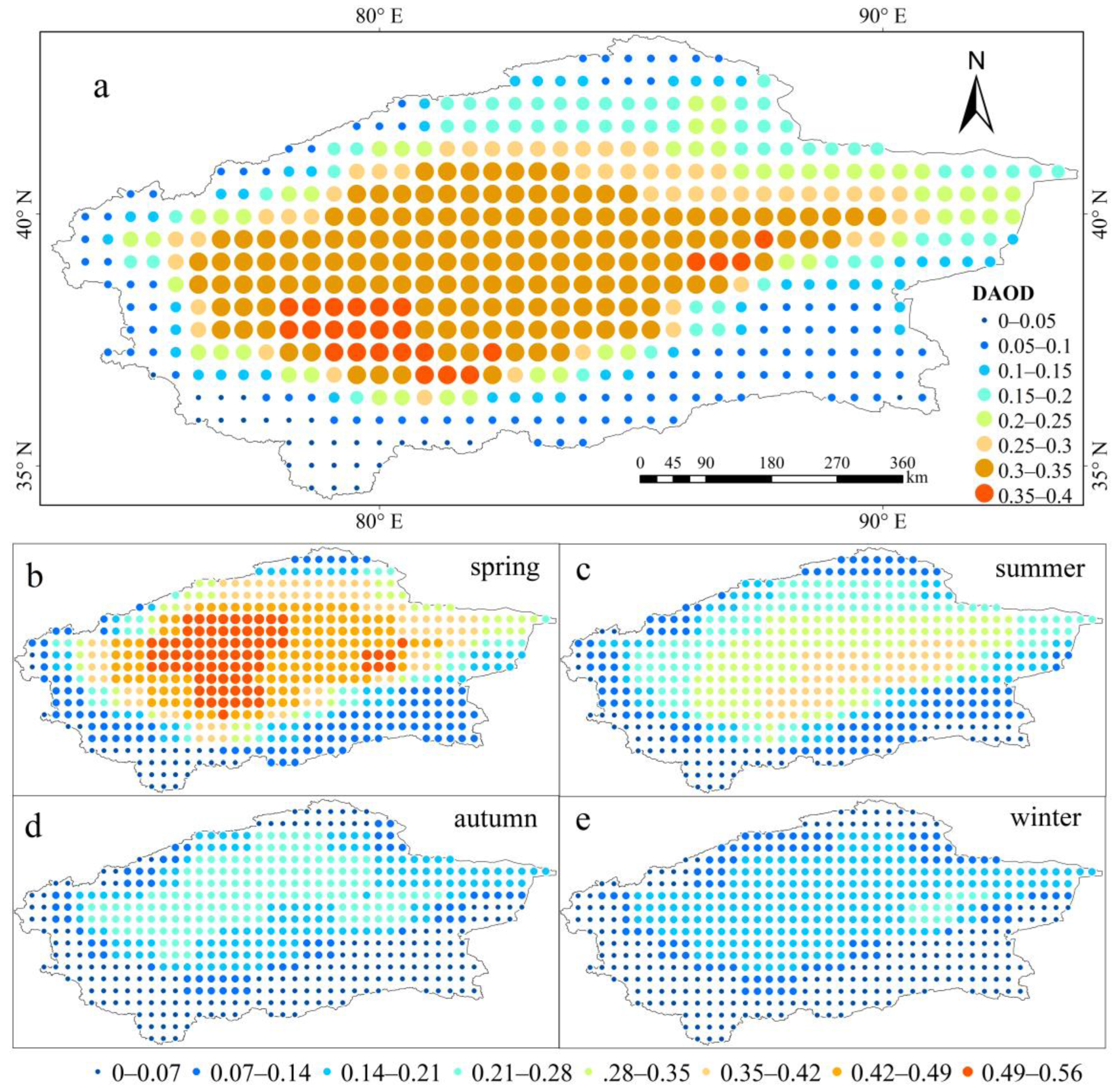

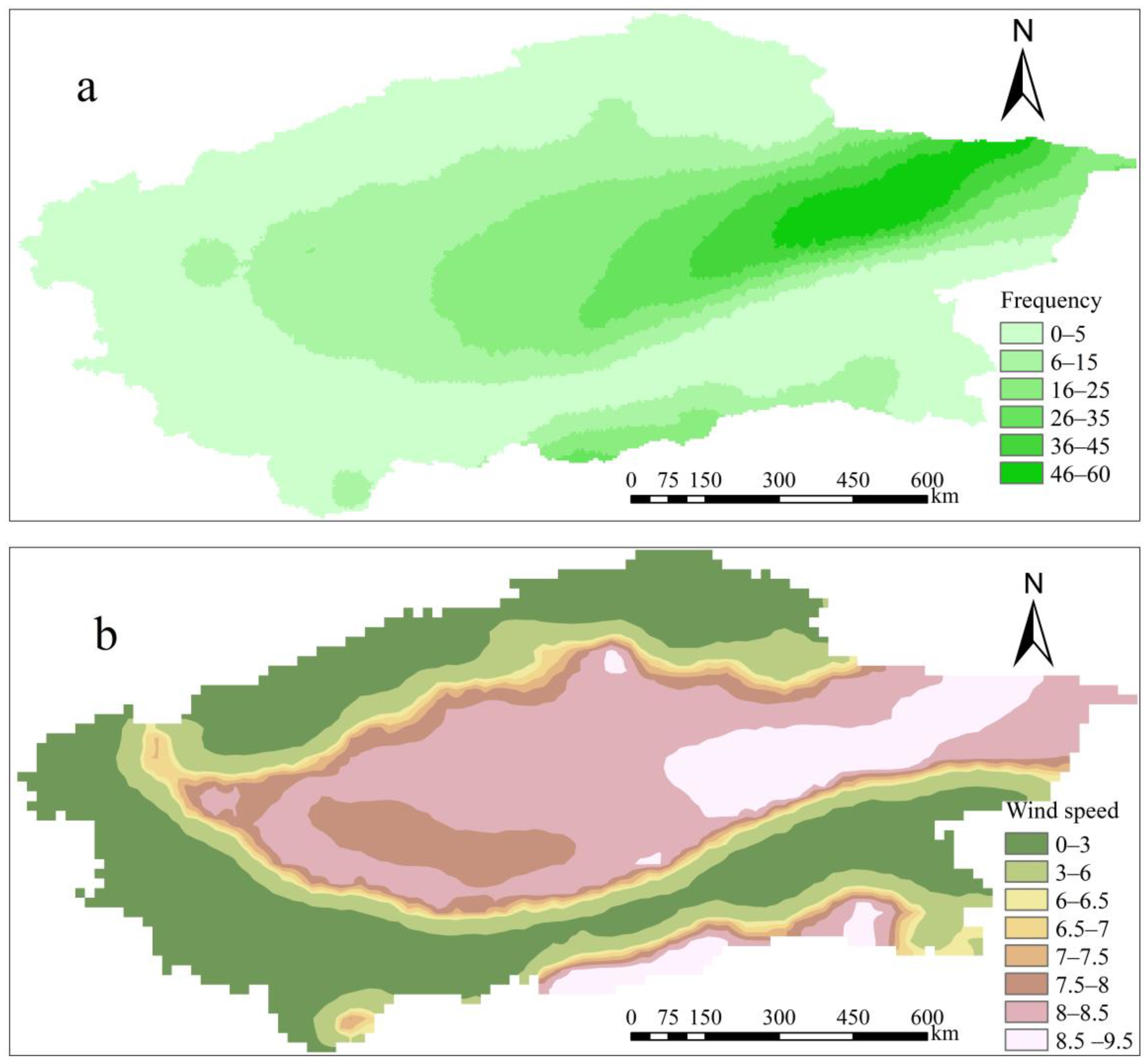
Disclaimer/Publisher’s Note: The statements, opinions and data contained in all publications are solely those of the individual author(s) and contributor(s) and not of MDPI and/or the editor(s). MDPI and/or the editor(s) disclaim responsibility for any injury to people or property resulting from any ideas, methods, instructions or products referred to in the content. |
© 2023 by the authors. Licensee MDPI, Basel, Switzerland. This article is an open access article distributed under the terms and conditions of the Creative Commons Attribution (CC BY) license (https://creativecommons.org/licenses/by/4.0/).
Share and Cite
Zhou, Y.; Gao, X.; Lei, J. Characteristics of Dust Weather in the Tarim Basin from 1989 to 2021 and Its Impact on the Atmospheric Environment. Remote Sens. 2023, 15, 1804. https://doi.org/10.3390/rs15071804
Zhou Y, Gao X, Lei J. Characteristics of Dust Weather in the Tarim Basin from 1989 to 2021 and Its Impact on the Atmospheric Environment. Remote Sensing. 2023; 15(7):1804. https://doi.org/10.3390/rs15071804
Chicago/Turabian StyleZhou, Yongchao, Xin Gao, and Jiaqiang Lei. 2023. "Characteristics of Dust Weather in the Tarim Basin from 1989 to 2021 and Its Impact on the Atmospheric Environment" Remote Sensing 15, no. 7: 1804. https://doi.org/10.3390/rs15071804
APA StyleZhou, Y., Gao, X., & Lei, J. (2023). Characteristics of Dust Weather in the Tarim Basin from 1989 to 2021 and Its Impact on the Atmospheric Environment. Remote Sensing, 15(7), 1804. https://doi.org/10.3390/rs15071804






